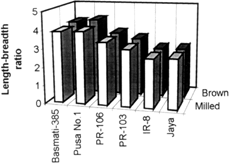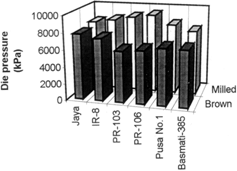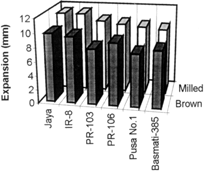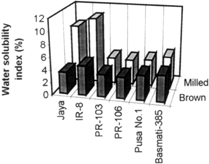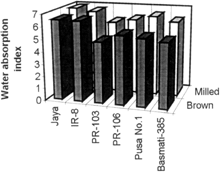ABSTRACT
Extrusion behaviour of milled and brown rice grits obtained from six rice cultivars (Jaya, IR-8, PR-103, PR-106, Pusa No.1 and Basmati 385) was investigated using Brabender single screw extruder. Feed moisture of the grits was adjusted to 16%, and extrusion cooking was done at barrel temperature of 150°C and screw speed of 100 rpm. The milled and brown rice grits from different rice cultivars differed significantly with respect to extrusion behaviour and extrudate characteristi cs. Extrudates obtained from milled rice grits showed higher die pressure, expansion, water absorption index (WAI) and water solubility index (WSI) as compared to those from brown rice. WSI of extrudates varied from 3.38 to 10.5%, WAI from 5.20 to 6.90, die pressure from 6068 to 9325 kPa and expansion from 7.52 to 11.30 respectively. The grits from cultivars which had lower length-breadth ratio and mealy endosperm resulted into more expanded extrudates and hence were found to be more suitable from extrusion.
INTRODUCTION
Extrusion cooking is used world wide for the production of expanded snack foods, modified starch, ready to eat cereal foods, pet foods and porridge.Citation1-3 Extrusion variables, composition of feed material, particle size distribution and additives significantly affect extrusion parameters and product properties.Citation4-9 Bhattachar yaCitation[10] investigated the effect of extrusion process variables on extrusion characteristics and extrudate properties during the extrusion cooking of a 1:1 rice-green gram (mung beans) blend using co-rotating twin screw extruder. The effect of the addition of Na2HPO4 and Na2H2PO4 with a change of process variables on the extrusion behaviour rice grits was studied. Citation[9] The effect of incorporating various hydrocolloids and processing variables on the extrusion behaviour and product characteristics of rice grits were studied.Citation[11] Sekhon et al.Citation[12] studied the effect of incorpora-ting rice bran in baked and extruded snack foods. The effect of substituting rice with extrusion cooked rice at different levels on the quality of idli was investigated.Citation[13]
Guha et al.Citation[14] studied the effect of extrusion variables on extrusion system parameters and product attributes during the extrusion cooking of rice flour. JulianoCitation[15] reported that rice cultivars differ significantly with respect to endosperm texture (vitreous and mealy). The objective of the present study was to investigate the extrusion behaviour of grits from different rice cultivars and effect of milling on the extrusion behaviour and extrudates characteristics.
MATERIAL AND METHODS
Paddy Samples
Six different paddy samples Jaya, IR-8, PR-103, PR-106, Pusa No. 1 and Basmati-385 were collected from Punjab Agriculture University Rice Research Station from 1999 harvest.
Preparation of Rice for Extrusion
The different paddy cultivars were dehusked in McGill rice sheller. One batch of brown rice was ground in a coffee grinder to produce brown rice grits. The other batch of brown rice was milled in a McGill rice miller to 7% degree of milling.Citation[16] The length breadth ratio was determined by dividing the length of ten kernels by the breadth of ten kernels. The milled rice was ground in a coffee grinder to milled rice grits. Both the brown and milled rice grits obtained were conditioned to 16% moisture content. The samples were packed in polyethylene bags and placed in a refrigerator overnight to equilibrate the moisture. The samples were brought to room temperature before extrusion cooking.
Extrusion Cooking
Extrusion cooking of brown and milled rice grits was carried out in a single screw extruder (C.W. Brabender, Hackensack, NJ) fitted with a die nozzle having 3.75 mm diameter with the specification as described earlier.Citation[9] The feed zone temperature was maintained at 75°C while the compression and die zone temperature was kept at 150°C.
Die Pressure
Die pressure was measured using Dynisco pressure transducer (Dynisco Ltd. USA) just before the discharge orifice. Readings were recorded every 10 s for at least 2 min and average was reported as kPa.
Expansion
The diameter of extrudates was measured as described earlierCitation[17] as the mean of 10 random measurements using a vernier calliper.
Water Solubility Index (WSI) and Water Absorption Index (WAI)
WSI and WAI were determined by the method of Anderson et al.[18] The extrudates were ground to pass through 60-mesh sieve. Extrudate sample (2.5 g) was dispersed in 25 mL distilled water, using a glass rod to break up any lumps. After stirring for 30 min the dispersions were rinsed into tarred centrifuge tubes and then centrifuged at 3000 g for 10 min. The supernatant was decanted for determination of its solids content and the sediments were weighed. WSI and WAI were calculated by the following equations.
Statistical Analysis
The date on length breadth ratio, die pressure, WAI, WSI and expansion was subjected to analysis of variance (Minitab Statistical Software) to determine the significant effect of milling and cultivars on the length breadth ratio, extrusion parameters and extrudate characteristics.
RESULTS AND DISCUSSION
The brown and milled rice were ground to obtain grits and the particle size of the grit was such that all of it passed through 20 mesh sieve and 99% was retained by 60 mesh sieve. The feed moisture, extrusion temperature and screw speed were kept constant at 16% 150°C and 100 rpm, respectively. The six rice cultivars selected for the study had length breadth ratio between 2.69 and 4.20 (Fig. ). The milling of brown rice to the extend of 7% lowered the length breadth ratio by 0.01, 1.11, 3.79, 1.86, 6.01 and 3.33% respectively, in Jaya, IR-8, PR-103, PR-106, Pusa No.1 and Basmati 385. Cultivars with higher length breadth ratio showed higher decrease in the length breadth ratio at same degree of milling. The analysis of variance of data in Fig. is given in Table . The cultivars differed more significant with respect to length breadth ratio (p<0.0005) as compared to the effect of milling on length breadth ratio (p<0.05).
Table 1. Analysis of Variance of Data on Length Breadth Ratio
Die Pressure
Figure illustrates the die pressure of the extruder for extruding brown and milled rice grits from different cultivars. Brown rice grits showed significantly lower die pressure as compared to the grits from their counter part milled rice in all the cultivars. Milling lowered the die pressure by 5.24, 15.72, 48.29, 48.56, 23.71 and 14.5% respectively in Jaya, IR-8, PR-103, PR-106, Pusa No.1 and Basmati 385. The lower die pressure in case of brown rice grits may be attributed to their higher fat and fibre content and lower starch content. Effects of addition of rice bran on die pressure of extruder have been reported earlier.Citation[12] The analysis of variance of data in Fig. is given in Table . The die pressure was more significantly affected by milling (p<0.05) and less affected by different cultivars.
Table 2. Analysis of Variance of Data on Die Pressure
Expansion
Figure illustrates the expansion of extrudates from brown and milled rice grits. Milled rice grits from different cultivars showed significantly higher expansion as compared to brown rice grits. These differences may be attributed to differences in chemical composition between milled rice grits. The brown rice grit has been reported to have higher amount of protein, minerals, fat and fibre content.Citation[15] These constituents have been reported to have a negative effect on expansion of cereals.Citation[7] Brown and milled rice grits from Jaya and IR-8 cultivars showed highest expansion while those from Pusa No. 1 and Basmati 385 showed lowest expansion (Fig. ). Milling increased the expansion ratio by 14.83, 18.98, 30.51,12.34, 28.85 and 15.88% respectively in Jaya, IR-8, PR-103, PR-106, Pusa No.1 and Basmati 385. The analysis of variance of data in Fig. is given in Table . The analysis revealed that milling had a greater effect on expansion of extrudates as compared to the effect of different cultivars.
Table 3. Analysis of Variance of Data on Expansion
Water Solubility Index
Figure shows WSI of extrudates from both brown and milled rice grits. The analysis of variance of data in Fig. is given in Table . The statistic al analysis indicated that milling had a more significant effect on WSI as compared to the effect of different cultivars. Extrudates from milled rice grits showed significantly higher WSI as compared to those from brown rice grits. The increase in WSI on milling was 162.24, 122.92, 16.80, 18.34, 8.35 and 17.85% respectively in Jaya, IR-8, PR-103, PR-106, Pusa No.1 and Basmati 385. These differences may be attributed to differences in structure of endosperm in different cultivars. The lower WSI of extrudate s from brown rice grits may be attributed to formation of amylose lipid complexCitation[19] since brown rice has been reported to have higher fat content as compared to milled rice.Citation[15]
Table 4. Analysis of Variance of Data on WSI
Water Absorption Index
Figure shows WAI of extrudates from both brown and milled rice grits from different cultivars. Extrudates from milled rice grits showed higher WAI as compared to their counterpart extrudates from brown rice grits. Milling of brown rice resulted in an increase in the WAI by 5.87, 2.85, 18.66, 10.74, 19.77 and 17.38% respectively, in Jaya, IR-8, PR-103, PR-106, Pusa No. 1 and Basmati 385. The higher WAI of extrudates from milled rice grits may be attributed to their higher starch content. The analysis of variance of data in Fig. is given in Table . The statistical analysis showed that milling had a more significant effect (p<0.005) on WAI as compared to the effect of cultivars (p<0.05).
Table 5. Analysis of Variance of Data on WAI
CONCLUSION
All the cultivars differ significantly with respect to extrusion behaviour and product characteristics. Die pressure of extruder, expansion, water solubility and water absorption indices increased with the milling of brown rice. Brown and milled rice obtained from varieties with lower length-breadth ratio (Jaya and IR-8) showed higher expansion as compared to their counterpart brown and milled rice obtained from varieties with higher length-breadth ratio (PR-103, PR-106, Pusa No. 1 and Basmati-385). The study revealed that cultivars (Jaya and IR-8) with a mealy opaque endosperm and low length-breadth ratio resulted into extrudates with greater expansion and water absorption indices.
Acknowledgments
REFERENCES
- Harper , J.M. 1981 . “ Extrusion of Starches and Starch Materials ” . In Extrusion of Food Vol. 2 , 41 – 60 . Boca Raton : CRC Press .
- Frame , N.D. 1994 . The Technology of Extrusion Cooking London : Blackie Academic and Professional .
- Smith , A.C. and Singh , N. 1996 . New Applications of Extrusion Technology . Indian Food Industry , 15 : 14 – 23 .
- Ryu , G.H. , Neumann , P.E. and Walker , C.E. 1993 . Effects of some Baking Ingredients on Physical and Structural Properties of Wheat Flour Extrudates . Cereal Chemistry , 70 : 291 – 297 .
- Yeh , A.I. and Huang , J.Y. 1995 . The Effect of Single Screw Extrusion Operation Variables on Properties of Rice Flour Extrudates . Food Science Taiwan , 22 : 124 – 140 .
- Singh , N. , Singh , B. , Sandhu , K.S. , Bawa , A.S. and Sekhon , K.S. 1996 . Extrusion Behaviour of Wheat, Rice and Potato Blends . Journal of Food Science and Technology , 33 : 291 – 294 .
- Singh , N. and Smith , A.C. 1997 . A Comparison of Wheat Starch, Whole Wheat Meal and Oat Flour in the Extrusion Process . Journal of Food Engineering , 34 : 15 – 32 .
- Singh , N. , Cairns , P. , Morris , V.J. and Smith , A.C. 1998a . Physical Properties of Extruded Wheat Starch Additive Mixtures . Cereal Chemistry , 75 : 325 – 330 .
- Singh , N. , Kaur , K. , Singh , B. and Sekhon , K.S. 1999 . Effect of Phosphate Salts on Extrusion Behaviour of Rice grits . Food Chemistry , 64 : 481 – 488 .
- Bhattacharya , S. 1997 . Twin-Screw Extrusion of Rice-Green Gram Blend: Extrusion and Extrudate Characteristics . Journal of Food Engineering , 32 : 83 – 99 .
- Kaur , K. , Singh , N. , Sekhon , K.S. and Singh , B. 1999 . Effect of Hydrocolloids and Process Variables on the Extrusion Behaviour of Rice Grits . Journal of Food Science and Technology , 36 : 127 – 132 .
- Sekhon , K.S. , Dhillon , S.S. , Singh , N. and Singh , B. 1997 . Suitability of Commercial Milled Rice Bran in India for Use in Different Food Products . Plant Foods for Human Nutrition , 50 : 127 – 140 .
- Singh , N. , Sekhon , K.S. and Nagi , H.P.S. 1994 . Effect of Temperature on the Extrusion Behaviour of Sound and Sprouted Wheat Flour . Journal of Food Science and Technology , 31 : 505 – 507 .
- Guha , M. , Zakiuddin , A.S. and Bhattacharya , S. 1997 . Twin Screw Extrusion of Rice Flour Without a Die: Effect of Barrel Temperature and Screw Speed on Extrusion and Extrudate Characteristics . Journal of Food Engineering , 32 : 251 – 267 .
- Juliano , B.O. and Bechtel , D.B. The Rice Grain and its Gross Composition. 1985 . Rice Chemistry and Technology 17 – 58 . St. Paul, Minnesota : The American Assosiation of Cereal Chemists,Inc .
- Singh , N. , Singh , H. , Kaur , K. and Bakshi , M.S. 2000 . Relationship Between the Degree of Milling, Ash Distribution Pattern and Conductivity in Brown Rice . Food Chemistry , 69 : 147 – 151 .
- Kirby , A.R. , Ollett , A.L. , Parker , R. and Smith , A.C. 1988 . An Experimental Study of Screw Configuration Effects in the Twin Screw Extrusion Cooking of Maize Grits . Journal of Food Engineering , 8 : 247 – 272 .
- Anderson , R.A. , Conway , H.F. , Pfeifer , V.F. and Griffin , E.J. 1969 . Jr . Gelatinization of Corn Grits by Roll and Extrusion Cooking. Cereal Science Today , 14 : 4 – 12 .
- Singh , N. , Smith , A.C. and Frame , N.D. 1988b . Effect of Process Variables and Glycerol Monostearate on the Extrusion Behaviour of Maize Grits Using Two Sizes of Extruders . Journal of Food Engineering , 35 : 91 – 109 .
